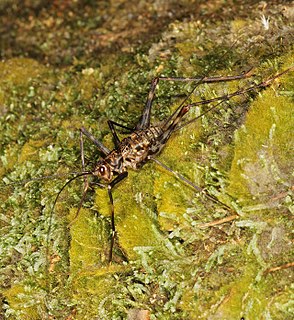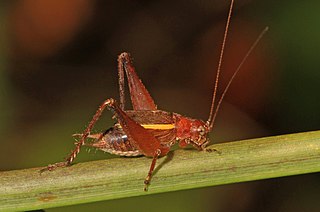
The family Gryllidae contains the subfamilies and genera which entomologists now term true crickets. They belong to the Orthopteran subfamily Ensifera, having long, whip-like antennae and has been reduced in terms of the older literature, with taxa such as the spider-crickets and allies, sword-tail crickets, wood or ground crickets and scaly crickets elevated to family level. The type genus is Gryllus and the first use of the family name "Gryllidae" was by Walker.

The family Prophalangopsidae are insects belonging to the order Orthoptera. They are the only extant members of the supefamily Hagloidea. There is only one extant genus in North America, where they are known as grigs, four genera in Asia, and many extinct genera.

Ensifera is a suborder of insects that includes the various types of crickets and their allies including: true crickets, camel crickets, bush crickets or katydids, grigs, weta and Cooloola monsters. This and the suborder Caelifera make up the order Orthoptera. Ensifera is believed to be a more ancient group than Caelifera, with its origins in the Carboniferous period, the split having occurred at the end of the Permian period. Unlike the Caelifera, the Ensifera contain numerous members that are partially carnivorous, feeding on other insects, as well as plants.

The Myrmecophilidae or ant-loving crickets are rarely encountered relatives of mole crickets, and are obligate inquilines within ant nests. They are very small, wingless, and flattened, so resemble small cockroach nymphs. The few genera contain fewer than 100 species. Ant crickets are yellow, brown, or nearly black in color. They do not produce sound, and lack both wings and tympanal organs ("ears") on the front tibia.

Phalangopsinae, occasionally known as spider crickets, are a subfamily of crickets in the family Phalangopsidae. Members of Phalangopsinae are found worldwide in tropical and subtropical regions. Most species in the subfamily are nocturnal and can be found in rocky areas, near fallen wood, and the understory of forests. Some species are gregarious, gathering in large numbers.
![Tridactylidae Family of [[Caelifera]]](https://upload.wikimedia.org/wikipedia/commons/thumb/2/24/Tridactylidae_IMG_1563m.JPG/320px-Tridactylidae_IMG_1563m.JPG)
The Tridactylidae are a family in the insect order Orthoptera. They are small, mole-cricket-like insects, almost always less than 20 mm (0.79 in) long when mature. Generally they are shiny, dark or black, sometimes variegated or sandy-coloured. They commonly live in short tunnels and are commonly known as pygmy mole crickets, though they are not closely related to the true "mole crickets" (Ensifera), as they are included in the Caelifera suborder.
The Eneopterinae are a subfamily of crickets, in the family Gryllidae, based on the type genus Eneoptera. It is one of several groups widely described as "true crickets". Of the more than 500 species that make up this subfamily, most occur in moist, tropical habitats. These insects are medium to large and brown or gray in color. They eat plant leaves, flowers, and fruits and can occasionally cause economic damage. Their eggs are deposited in pith, bark, or wood. Eneopterinae show a great diversity in stridulatory apparatus, signals emitted, and associated behaviour.

Mogoplistidae is a family of scaly crickets within the superfamily Grylloidea. Considered to be monophyletic, a sister taxon to the Gryllidae crickets. This family consists of 30 genera and 364 species worldwide; 20 species in 4 genera occur in North America and this family includes the scaly crickets of Europe.

Grylloidea is the superfamily of insects, in the order Orthoptera, known as crickets. It includes the "true crickets", scaly crickets, wood crickets and other families, some only known from fossils.

The Hexacentrinae, are a subfamily of predatory bush crickets or katydids. The type genus is Hexacentrus, which are also known as balloon-winged katydids. The group has sometimes been treated as a tribe within Conocephalinae, which may be a sister group. Members of this subfamily have lobules on the male paraprocts. Most of them also have a flat, wide hind lobe of the pronotum.

The superfamily Hagloidea are insects belonging to the order Orthoptera: Ensifera; they are now represented by the extant Prophalangopsidae, with many extinct genera and families.
Gryllidea is an infraorder that includes crickets and similar insects in the order Orthoptera. There are two superfamilies, and more than 6,000 described species in Gryllidea.

The Phalangopsidae are a recently reconstituted family of crickets, based on the type genus PhalangopsisServille, 1831 from South America. Priority for family-group names based on this genus dates from Blanchard's "Phalangopsites".
The Phaloriinae is a subfamily of crickets of the family Phalangopsidae. Species are terrestrial and are distributed in: Africa, tropical Asia, Korea, Australia and the Pacific Islands.
The Landrevinae are a subfamily of crickets, in the family Gryllidae, based on the type genus Landreva. They are terrestrial, omnivorous and may be known as "bark crickets"; genera are distributed in: Central and South America, Africa, tropical Asia, Korea, Japan, Australia and the Pacific Islands.

Hapithini is a tribe of crickets in the subfamily Hapithinae. There are about 12 genera and more than 260 described species: found in Central and South America.
Aphonomorphini is a tribe of crickets in the subfamily Hapithinae. There are about 6 genera and more than 90 described species in Aphonomorphini.
Locustopsidae is an extinct family of grasshoppers in the order Orthoptera. There are about 17 genera and more than 60 described species in Locustopsidae.
Protogryllidae is an extinct family of crickets in the order Orthoptera. There are about 8 genera and more than 20 described species in Protogryllidae.

Elcanidae are an extinct family of Mesozoic and early Cenozoic ensiferans. Members of the family are distinguished by the presence of spurs on the distal part of the metatibia, unique among orthopterans, these have been suggested to have been used for controlling gliding, swimming aids, or for jumping on water. They are known from the Late Triassic to Paleocene of Eurasia, North and South America.





![Tridactylidae Family of [[Caelifera]]](https://upload.wikimedia.org/wikipedia/commons/thumb/2/24/Tridactylidae_IMG_1563m.JPG/320px-Tridactylidae_IMG_1563m.JPG)




